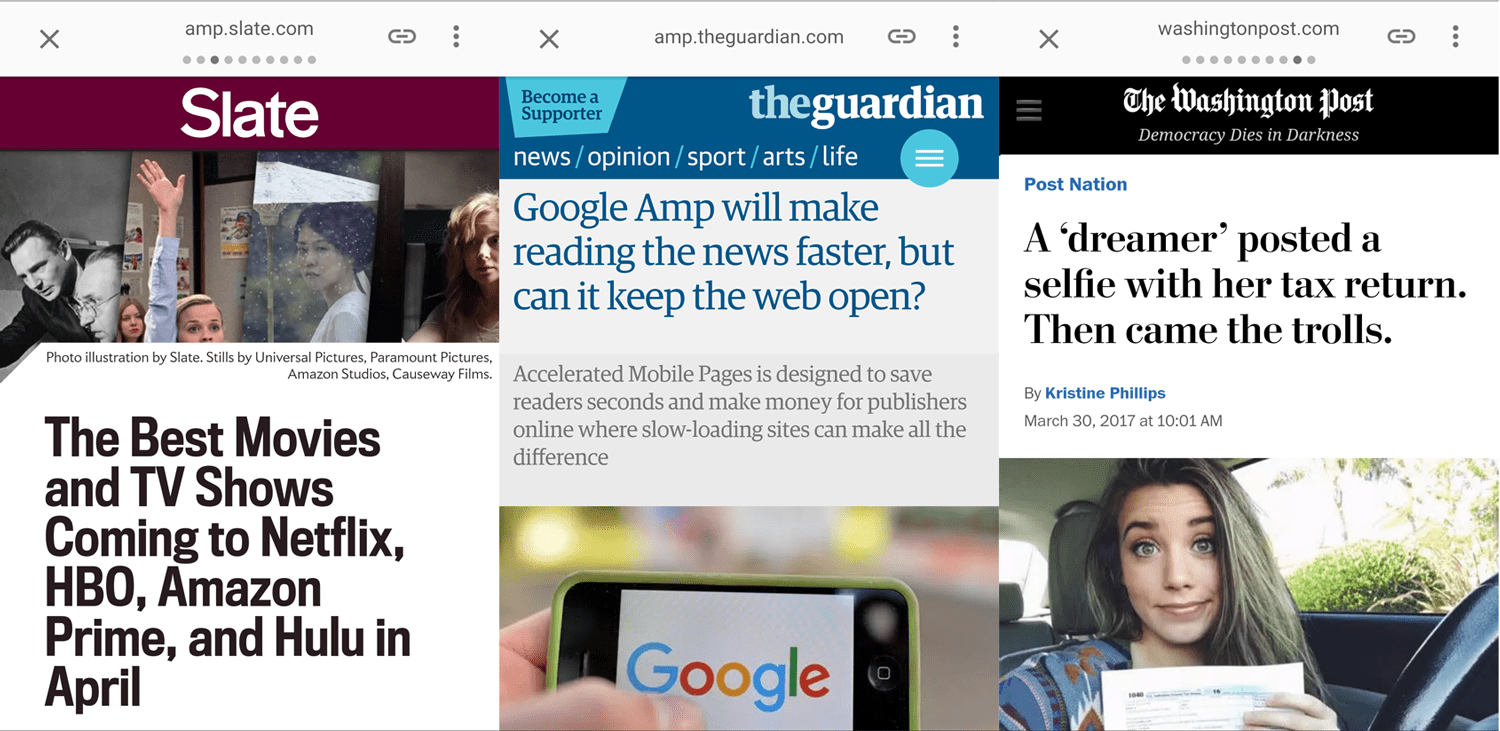
The Advent of Google AMP & Impact
Internet users expect websites to load super fast on their mobiles. It is because most of the time, a website takes several seconds to load on a mobile. Because of the delay in site load, users would abandon sites and impact the session duration and the bounce rate. To resolve this issue, around Feb 24, 2016, Google came up with Accelerated Mobile Pages Project (AMP), an open-source initiative to improve the mobile web experience for every user.
Improved loading time would mean more visitors influencing the website’s trust factor to rank on page 1. But, most publishers refused AMP as it stripped rich content to fit the Google server to the extent that it would get difficult for readers to tell apart fake articles and phishing clickbait stories from legitimate news. As a result, Google penalized publishers that didn’t sign up for the AMP project by refusing them the top position.
Google’s AMP Update & New Consideration
In the winter of 2020, Google shared that they would soon phase out their AMP project, and now, starting June 2021, Google’s AMP project would no more influence the ranking of websites on Google search. Websites using AMP will receive preferential treatment in Google’s search results, Top Stories carousel, or Google News. Google will also remove the AMP badge icon from the search results. Website developers concerned about UI/UX can now disregard the AMP version.
As per Google’s announcement, Google is considering mobile page experience that earlier prioritized AMP pages. But now, Google would prioritize pages that comply with Google News content policies. Websites that continue to use AMP will see no difference. Additionally, it’ll also consider the three Core Web Vitals metrics: LCP, FID, and CLS (as well as Chrome’s recent fix to CLS). Core Web Vitals score will no longer determine a position in the Top Stories carousel.

The Allegation of News Media Alliance
While many news sites did admit some benefit of the technology, the News Media Alliance alleged Google AMP for sabotaging revenue and conversion of readers to subscribers. While AMP readers didn’t proceed to the next article, subscribers per million readers recorded through AMP links were 39 percent lower than through non-AMP links. The Alliance states that “Given that reality, Google should be entering into fair negotiations, and mutually acceptable written agreements, with the news publishers for each specific contemplated use of their content, negotiations that would allow the news industry to attempt to negotiate compensation and control if the playing field were remotely equal.”
The Case with Kinsta & the Inference
In an article, Kinsta reported a drop in leads by 59%. As Kinsta opted for AMP, “their mobile leads dropped by 59.09%, newsletter sign-ups from mobile dropped by 16.67%, and mobile account creation dropped 10.53%.” Kinsta also identified that news sites benefited from AMP compared to non-news sites. In the article, Kinsta also referred to Google talking about 70% of global cellular networks operating at 3G or lower. Optimizing pages for mobile readership was therefore considered a solution. But eventually, Kinsta had to drop out.
Cooperative Syndication, the Alternative
Researches have been working parallel on this front to find out some alternative. Robin Berjon and Justin Heideman likened Google AMP, also used by Microsoft Bing and Twitter, to Apple News Format and Facebook Instant Articles [FBIA] to identify how publishers lose proprietary formats. Both Berjon and Heideman have new technology in the offing, and that’s Cooperative Syndication aggregation architecture. Read the draft here.
Post Google AMP, A Guide for WebMasters
As a webmaster for a business site, are confused about your next course of action? Well, the process is not very complex. If your website is built on WordPress and you’ve used the AMP plugin, disable it. Once you disable it, use the 404 Redirect plugin to retain the AMP link juice. You can also refer to Google’s Remove your Google pages from AMP Search. If you are not a news site, you might ignore it if you didn’t realize any impact already.
All webmasters must have come across Site Performance with the Google Site Kit on their WordPress dashboard.

The Core Web Vitals that Google studies to measure Page Experience for search ranking include-
- LCP or Largest Contentful Paint: The speed at which the largest piece of content (an image or block of text) appears on the user’s screen.
- FID, or First Input Delay: The speed at which a site interacts on the fast tap generates a response on click.
- CLS, or Cumulative Layout Shift: The case of a site’s visual stability. One must check if elements are moving around as the full site loads.
Web admins focusing on website loading performance, interactivity, and visual stability concerning the above three definitions are ready for the game.
Dear Reader,
First, thank you for your precious time reading the stories (without paywalls) I publish on Startups to Enterprises covering the EU, China, the US, and India. Second, I request you to contribute financially (any amount) to help me sustain this as an independent digital business news media.
If I receive a request for a sponsored post, I ensure I see merit that is meaningful for erudite and informed readers like you. In the bargain, I lose out on sponsorships wherein I need funds to sustain this effort. Your contribution helps me stay afloat.
Please note that your contribution is treated as revenue generated and not a donation; hence, there are no 80G or other donation certificates. In fact, as I am eligible to pay for the revenue generated, I will pay taxes on the same.
You deserve to know that I abide by journalistic ethics and practices to ensure I tell the stories as is, unbiased. You can follow us on Facebook, Linkedin, and Twitter, bookmark us on Google News, and finally, PayPal us here.
Founding Editor
Linda Ashok

